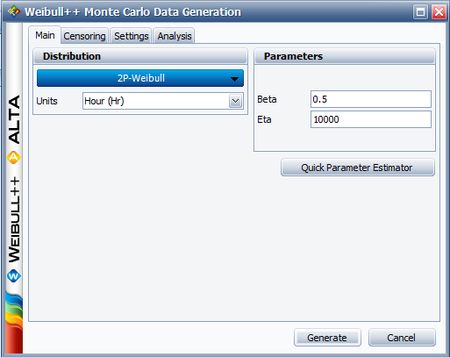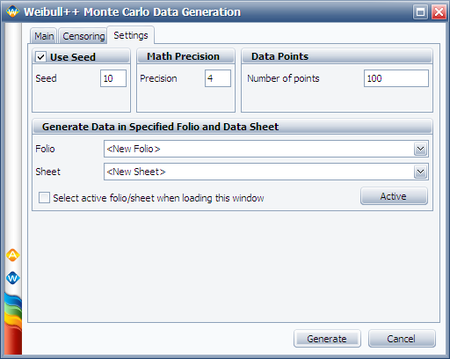Gumbel Distribution Example: Difference between revisions
Kate Racaza (talk | contribs) (removed link to http://reliawiki.org/index.php/Example:_Gumbel_Distribution) |
No edit summary |
||
| Line 5: | Line 5: | ||
Let us assume that <math>{{t}_{i}}</math> follows a Weibull distribution with <math>\beta =0.5</math> and <math>\eta =10000.</math> The Monte Carlo simulation tool in Weibull++ can be used to generate a set of random numbers that follow a Weibull distribution with the specified parameters. | Let us assume that <math>{{t}_{i}}</math> follows a Weibull distribution with <math>\beta =0.5</math> and <math>\eta =10000.</math> The Monte Carlo simulation tool in Weibull++ can be used to generate a set of random numbers that follow a Weibull distribution with the specified parameters. | ||
[[Image:montecarlo4eva.png|thumb|center| | [[Image:montecarlo4eva.png|thumb|center|450px| ]] | ||
Other simulation settings are: | Other simulation settings are: | ||
[[Image:Gumbel Distribution Example 1 Simulation Setting.png|thumb|center| | [[Image:Gumbel Distribution Example 1 Simulation Setting.png|thumb|center|450px| ]] | ||
After obtaining the random time values <math>{{t}_{i}}</math> , insert a new Data Sheet using the Insert Data Sheet option under the Folio menu. In this sheet enter the <math>Ln({{t}_{i}})</math> values using the LN function and referring to the cells in the sheet that contains the <math>{{t}_{i}}</math> values. Delete any negative values, if there are any, since Weibull++ expects time values to be positive. Calculate the parameters of the Gumbel distribution that fits the <math>Ln({{t}_{i}})</math> values. | After obtaining the random time values <math>{{t}_{i}}</math> , insert a new Data Sheet using the Insert Data Sheet option under the Folio menu. In this sheet enter the <math>Ln({{t}_{i}})</math> values using the LN function and referring to the cells in the sheet that contains the <math>{{t}_{i}}</math> values. Delete any negative values, if there are any, since Weibull++ expects time values to be positive. Calculate the parameters of the Gumbel distribution that fits the <math>Ln({{t}_{i}})</math> values. | ||
| Line 19: | Line 19: | ||
& \hat{\sigma }= & 1.9717 | & \hat{\sigma }= & 1.9717 | ||
\end{align}</math> | \end{align}</math> | ||
Since <math>\ln (\eta )=</math> 9.2103 ( <math>\simeq 9.3816</math> ) and <math>1/\beta =2</math> <math>(\simeq 1.9717),</math> then this simulation verifies that <math>Ln({{t}_{i}})</math> follows a Gumbel distribution with <math>\mu =\ln (\eta )</math> and <math>\delta =1/\beta .</math> | Since <math>\ln (\eta )=</math> 9.2103 ( <math>\simeq 9.3816</math> ) and <math>1/\beta =2</math> <math>(\simeq 1.9717),</math> then this simulation verifies that <math>Ln({{t}_{i}})</math> follows a Gumbel distribution with <math>\mu =\ln (\eta )</math> and <math>\delta =1/\beta .</math> | ||
Note: This example illustrates a property of the Gumbel distribution; it is not meant to be a formal proof. | Note: This example illustrates a property of the Gumbel distribution; it is not meant to be a formal proof. | ||
Revision as of 03:45, 6 August 2012
A Gumbel Distribution Example
Verify using Monte Carlo simulation that if [math]\displaystyle{ {{t}_{i}} }[/math] follows a Weibull distribution with [math]\displaystyle{ \beta }[/math] and [math]\displaystyle{ \eta }[/math] , then the [math]\displaystyle{ Ln({{t}_{i}}) }[/math] follows a Gumbel distribution with [math]\displaystyle{ \mu =\ln (\eta ) }[/math] and [math]\displaystyle{ \sigma =1/\beta ). }[/math]
Let us assume that [math]\displaystyle{ {{t}_{i}} }[/math] follows a Weibull distribution with [math]\displaystyle{ \beta =0.5 }[/math] and [math]\displaystyle{ \eta =10000. }[/math] The Monte Carlo simulation tool in Weibull++ can be used to generate a set of random numbers that follow a Weibull distribution with the specified parameters.
Other simulation settings are:
After obtaining the random time values [math]\displaystyle{ {{t}_{i}} }[/math] , insert a new Data Sheet using the Insert Data Sheet option under the Folio menu. In this sheet enter the [math]\displaystyle{ Ln({{t}_{i}}) }[/math] values using the LN function and referring to the cells in the sheet that contains the [math]\displaystyle{ {{t}_{i}} }[/math] values. Delete any negative values, if there are any, since Weibull++ expects time values to be positive. Calculate the parameters of the Gumbel distribution that fits the [math]\displaystyle{ Ln({{t}_{i}}) }[/math] values.
Using maximum likelihood as the analysis method, the estimated parameters are:
- [math]\displaystyle{ \begin{align} & \hat{\mu }= & 9.3816 \\ & \hat{\sigma }= & 1.9717 \end{align} }[/math]
Since [math]\displaystyle{ \ln (\eta )= }[/math] 9.2103 ( [math]\displaystyle{ \simeq 9.3816 }[/math] ) and [math]\displaystyle{ 1/\beta =2 }[/math] [math]\displaystyle{ (\simeq 1.9717), }[/math] then this simulation verifies that [math]\displaystyle{ Ln({{t}_{i}}) }[/math] follows a Gumbel distribution with [math]\displaystyle{ \mu =\ln (\eta ) }[/math] and [math]\displaystyle{ \delta =1/\beta . }[/math]
Note: This example illustrates a property of the Gumbel distribution; it is not meant to be a formal proof.

